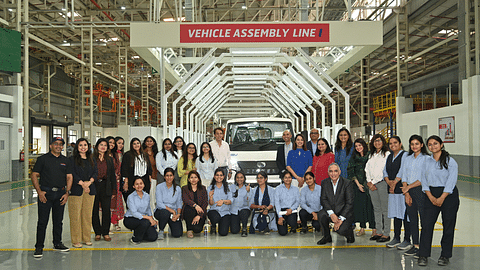New Safety Rules: Better Brakes and Alerts for Buses and Trucks Next Year

The road is an unpredictable place. One moment, everything is smooth sailing; the next, disaster looms due to a split-second delay in reaction time. Recognizing this, the Ministry of Road Transport and Highways (MoRTH) has introduced a game-changing safety mandate for commercial vehicles. Come April 2026, all newly manufactured buses and trucks must be equipped with cutting-edge safety features designed to curb accidents and save lives.
What’s Changing?
To enhance road safety, authorities are making it compulsory for passenger vehicles carrying more than eight occupants, including buses and trucks, to incorporate Advanced Emergency Braking Systems (AEBS), Driver Drowsiness and Attention Warning Systems (DDAWS), and Lane Departure Warning Systems (LDWS). These technologies aren’t just additions—they are life-saving innovations.
Breaking Down the Tech: How Will These Features Help?
- Advanced Emergency Braking System (AEBS): Imagine a truck barrelling down the highway, the driver momentarily distracted. AEBS steps in, detecting an imminent collision and applying the brakes autonomously if the driver doesn’t react in time. This not only reduces impact severity but can also prevent crashes altogether.
- Driver Drowsiness and Attention Warning System (DDAWS): Long-haul truckers often battle fatigue, and fatigue leads to errors. DDAWS monitors subtle cues—steering patterns, lane positioning, even facial expressions—to detect signs of drowsiness. The moment it senses a lapse in attention, it alerts the driver, snapping them back to focus.
- Lane Departure Warning System (LDWS): Drifting out of a lane without signaling is a common yet dangerous occurrence. LDWS mitigates this by issuing visual, auditory, or haptic warnings whenever unintended lane shifts are detected, ensuring drivers remain on course.
The Bigger Picture: A Safer Future for Commercial Vehicles
Safety doesn’t stop at braking and alerts. All mini and regular buses, along with trucks, will also be required to have a vehicle stability function and AEBS to minimize road mishaps. These advanced systems work together to create a safety net, dramatically reducing human error—the leading cause of accidents.
But that’s not all. The transition won’t happen overnight. While all newly manufactured commercial vehicles must comply by April 2026, existing models will need to integrate these systems by October 2026 to ensure a universal safety standard.
Final Thoughts: A Landmark Move in Road Safety
This regulatory push signals a paradigm shift in India’s approach to road safety. By embedding intelligent safety mechanisms into commercial vehicles, the government is not only protecting drivers and passengers but also pedestrians and fellow motorists. With lives at stake, these measures aren't just necessary—they're long overdue.
For more articles and news, stay updated with 91trucks. Subscribe to our YouTube channel and follow us on Facebook, Instagram, and Linkedin for the latest videos and updates from the automotive world!
Latest Industry Insights News
View All Industry Insights NewsRecent Posts
- Eicher Trucks Hosts 2nd Women Transporters Delegation on eco-tech.
- New Safety Rules: Better Brakes and Alerts for Buses and Trucks Next Year
- रिन्युएबल नेचुरल गैस: हैवी-ड्यूटी ट्रक फ्लीट के लिए भविष्य का ईंधन
- नई सुरक्षा नियम: अगले वर्ष बसों और ट्रकों के लिए बेहतर ब्रेकिंग और अलर्ट सिस्टम
- Heavy-Duty Truck Fleet: Make Way for Renewable Natural Gas
- अशोक लीलैंड के शेयर 4% उछले, एसएमएल इसुज़ु में हिस्सेदारी खरीदने की अटकलों से बाजार में हलचल
- Global Commercial Vehicles Market to Hit USD 910.05 Billion by 2034
- Ashok Leyland Shares Soar 4% on SML Isuzu Stake Acquisition Speculation
- आयशर ने मुंबई में आयशर प्रो एक्स छोटे ट्रकों के लिए पहला डीलरशिप उद्घाटन किया
- वाणिज्यिक वाहन बाजार 2034 तक 910.05 बिलियन अमेरिकी डॉलर से अधिक पहुंचने के लिए तैयार
Popular Three Wheelers Brands
 Altigreen
Altigreen Euler Motors
Euler Motors Mahindra
Mahindra Piaggio
Piaggio Bajaj
Bajaj Greaves Mobility
Greaves Mobility ATUL
ATUL TVS
TVS Omega Seiki Mobility
Omega Seiki Mobility Kinetic
Kinetic Lohia
Lohia JSA
JSA YC Electric
YC Electric Udaan
Udaan SN Solar Energy
SN Solar Energy Saarthi
Saarthi Teja (Powered by Greaves)
Teja (Powered by Greaves) Jezza Motors
Jezza Motors GreenRick
GreenRick City Life Electric
City Life Electric Ampere
Ampere Baba Electric
Baba Electric E-Ashwa
E-Ashwa Bahubali E Rickshaw
Bahubali E Rickshaw Dabang
Dabang Deltic
Deltic Keto Motors
Keto Motors Mini Metro
Mini Metro Gayam Motors
Gayam Motors Gem EV
Gem EV Gkon Automotive
Gkon Automotive Skyride
Skyride Thukral Electric
Thukral Electric Baxy
Baxy Eblu
Eblu Hexall
Hexall Joy
Joy Montra
Montra Star
Star Dandera
Dandera EKA
EKA Khalsa
Khalsa Hero
Hero- Zero21
 Sodyco
Sodyco Speego
Speego- Wasan e-Mobility
 Raftaar Electric
Raftaar Electric Zen Mobility
Zen Mobility- Rajhans
 Zelio
Zelio Rayon Engineers
Rayon Engineers Vani Moto
Vani Moto Om Raj Autotech
Om Raj Autotech Victory
Victory Sniper Electric
Sniper Electric Veectero
Veectero Vande Bharat
Vande Bharat OPG Mobility
OPG Mobility Top Team Machines
Top Team Machines- Shaktimaan E-Rickshaw
 Singham
Singham Triton EV
Triton EV Panther
Panther- Terra Motors
 OK Play
OK Play Tejas Vehicles
Tejas Vehicles Supertech EV
Supertech EV Syndicate Motors
Syndicate Motors SuperEco
SuperEco Shakti Auto Green
Shakti Auto Green Star Bull
Star Bull Sathi
Sathi Statix Electric
Statix Electric Om Balajee Automobiles
Om Balajee Automobiles Savy Electric
Savy Electric Sargam E Ride
Sargam E Ride NRJ
NRJ Speedways Electric
Speedways Electric Kuku Automotives
Kuku Automotives Komaki
Komaki
91trucks is a rapidly growing digital platform that offers the latest updates and comprehensive information about the commercial vehicle industry.








